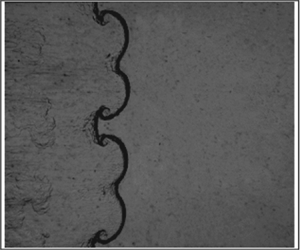Article contents
Richtmyer–Meshkov instability on a dual-mode interface
Published online by Cambridge University Press: 20 October 2020
Abstract

We report the first shock-tube experiments on dual-mode Richtmyer–Meshkov instability (RMI). An extended soap-film technique is adopted to generate a dual-mode gaseous interface such that its initial wavenumber ( $k_0$) and phase of the fundamental waves are well controlled. By extracting interfacial contours from the distinct schlieren images, a Fourier analysis is performed from linear to weakly nonlinear stages and the growth of each basic wave is obtained. A noticeable difference between the growth of each basic mode and the corresponding single-mode RMI is observed, which suggests evident mode coupling effects in the dual-mode RMI. For dual-mode interfaces with in-phase
$k_0$) and phase of the fundamental waves are well controlled. By extracting interfacial contours from the distinct schlieren images, a Fourier analysis is performed from linear to weakly nonlinear stages and the growth of each basic wave is obtained. A noticeable difference between the growth of each basic mode and the corresponding single-mode RMI is observed, which suggests evident mode coupling effects in the dual-mode RMI. For dual-mode interfaces with in-phase  $k_0$ and
$k_0$ and  $k_0/2$ waves, the mode coupling suppresses (promotes) the growth of the
$k_0/2$ waves, the mode coupling suppresses (promotes) the growth of the  $k_0$ (
$k_0$ ( $k_0/2$) mode, while for interfaces with anti-phase
$k_0/2$) mode, while for interfaces with anti-phase  $k_0$ and
$k_0$ and  $k_0/2$ modes, the growth of the
$k_0/2$ modes, the growth of the  $k_0$ (
$k_0$ ( $k_0/2$) mode is weakly influenced (evidently inhibited). However, for the combination of
$k_0/2$) mode is weakly influenced (evidently inhibited). However, for the combination of  $k_0$ and
$k_0$ and  $k_0/3$ waves, the mode coupling has a negligible influence on the growth of each basic wave. The modal theory of Haan (Phys. Fluids B, vol. 3, 1991, pp. 2349–2355), originally for multi-mode Rayleigh–Taylor instability, is reformulated for the dual-mode RMI, and it is found that this model overestimates the present experimental results for ignoring the nonlinear saturation. This model is then modified by accounting for both the mode coupling and nonlinear saturation, which well predicts the experimental results not only for the growth of the basic waves but also for the growth of second harmonics.
$k_0/3$ waves, the mode coupling has a negligible influence on the growth of each basic wave. The modal theory of Haan (Phys. Fluids B, vol. 3, 1991, pp. 2349–2355), originally for multi-mode Rayleigh–Taylor instability, is reformulated for the dual-mode RMI, and it is found that this model overestimates the present experimental results for ignoring the nonlinear saturation. This model is then modified by accounting for both the mode coupling and nonlinear saturation, which well predicts the experimental results not only for the growth of the basic waves but also for the growth of second harmonics.
JFM classification
- Type
- JFM Papers
- Information
- Copyright
- © The Author(s), 2020. Published by Cambridge University Press
References
REFERENCES
- 9
- Cited by





